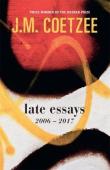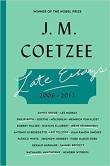AustLit
Latest Issues
AbstractHistoryArchive Description
'Crossing J.M. Coetzee's range of well-known writerly interests, including Beckett, with essays on Australian writers including Gerald Murnane, Patrick White and Les Murray.The subjects covered range from Daniel Defoe in the early eighteenth century to Coetzee's contemporary Philip Roth. Coetzee has had a long-standing interest in German literature and here he engages with the work of Goethe, Holderlin, Kleist and Walser. There are four fascinating essays on fellow Nobel laureate Samuel Beckett. There are essays too on Tolstoy's great novella The Death of Ivan Ilyich, on Flaubert's masterpiece Madame Bovary, and on the Argentine modernist Antonio Di Benedetto. J.M. Coetzee, a great novelist himself, is a wise and insightful guide to these works of international literature that span three centuries.' (Publication Summary)
Notes
-
Also contains essays on international authors
Contents
- Late Patrick White, single work essay (p. 218)
- Patrick White, The Solid Mandala, single work essay (p. 234)
Publication Details of Only Known VersionEarliest 2 Known Versions of
Works about this Work
-
Magda Meets Theodora : Language and Interiority in The Aunt’s Story and In The Heart of the Country
2018
single work
criticism
— Appears in: Australian Literary Studies , February vol. 33 no. 1 2018;'In ‘Orders of Discourse’ Foucault raises the deeply embedded opposition between reason and folly: ‘From the depths of the Middle Ages a man was mad if his speech could not be said to form part of the common discourse of men’. This discursive rule becomes magnified in the case of women and of the colonised. In Coetzee’s In the Heart of the Country and Patrick White’s The Aunt’s Story, Magda and Theodora demonstrate the precarious marginality of the colonial woman. They are doubly marginalised as colonial women, existing outside settler history, which is the narrative both of the masculine responsibilities of settlement and an attendant sense of displacement. In Coetzee’s novel, Magda plays out a version of The Tempest in which she is subjected both to the Law of the Father and to Caliban, while in The Aunt’s Story Theodora plots a determined path out of the discourse of men into the ambivalently liberating horizon of madness. The differences between the women say as much as the similarities, but both offer a compelling version of the layered marginalities of the female colonial subject. In the writers’ hands the place outside discourse, the peculiar language of the colonial women, becomes the potential location of counter discourse. This essay proposes that the women demonstrate a radical interiority, a capacity to inhabit the lives of others in a way that is considered madness but which enacts the utopian function of literature itself.' (Publication abstract)
-
Sly Late Style
2017
single work
essay
— Appears in: The Monthly , September no. 137 2017; (p. 54-56)'Coetzee the critic is every bit as good as Coetzee the novelist,” the Irish Times said of his third essay collection back in 2001. For Late Essays: 2006-201/7 (Knopf Australia; $29.99), his fifth, his publishers use the blurb again, and no one should argue with the praise.' (Introduction)
-
Coetzee and the Value of Silence
2017
single work
essay
review
— Appears in: The Weekend Australian , 9 September 2017; (p. 22)'JM Coetzee is the Nobel laureate from South Africa who moved to Adelaide in 2002 and became an Australian citizen four years later. He is not only the most internationally acclaimed writer at work in this country but also, a bit less obviously, arguably the most eminent figure since Matthew Arnold to be a major writer while also continuing to teach literature at a university.' (Introduction)
-
An Inside View : The Master of Slow Reading
2017
single work
essay
review
— Appears in: Australian Book Review , September no. 394 2017; (p. 11-12)'While it is true that the essay as a genre has a long and continuous history, it is not always an easy form to categorise or define. J.M. Coetzee has himself contrasted the ‘rather tight discourse’ of criticism with the relative freedom of writing fiction. Indeed, essays – like those collected in this volume – require ‘slow reading’, a term derived from Friedrich Nietzsche’s statement that he was a ‘teacher of slow reading’. Coetzee’s essays, twenty-three of which are collected here as Late Essays: 2006–2017, are exemplars of his own careful reading while also providing engaging, accessible, and informative insights into writers and their works. They have all been previously published, either as introductions to new editions of books, as book chapters, or as reviews (most notably in the New York Review of Books, to which Coetzee regularly contributes). Unlike his novels, the essays are direct and unambiguous, offering not only one writer’s evaluation of another writer but also the astute assessments of a lifelong teacher of literature.' (Introduction)
-
An Inside View : The Master of Slow Reading
2017
single work
essay
review
— Appears in: Australian Book Review , September no. 394 2017; (p. 11-12)'While it is true that the essay as a genre has a long and continuous history, it is not always an easy form to categorise or define. J.M. Coetzee has himself contrasted the ‘rather tight discourse’ of criticism with the relative freedom of writing fiction. Indeed, essays – like those collected in this volume – require ‘slow reading’, a term derived from Friedrich Nietzsche’s statement that he was a ‘teacher of slow reading’. Coetzee’s essays, twenty-three of which are collected here as Late Essays: 2006–2017, are exemplars of his own careful reading while also providing engaging, accessible, and informative insights into writers and their works. They have all been previously published, either as introductions to new editions of books, as book chapters, or as reviews (most notably in the New York Review of Books, to which Coetzee regularly contributes). Unlike his novels, the essays are direct and unambiguous, offering not only one writer’s evaluation of another writer but also the astute assessments of a lifelong teacher of literature.' (Introduction)
-
Coetzee and the Value of Silence
2017
single work
essay
review
— Appears in: The Weekend Australian , 9 September 2017; (p. 22)'JM Coetzee is the Nobel laureate from South Africa who moved to Adelaide in 2002 and became an Australian citizen four years later. He is not only the most internationally acclaimed writer at work in this country but also, a bit less obviously, arguably the most eminent figure since Matthew Arnold to be a major writer while also continuing to teach literature at a university.' (Introduction)
-
Sly Late Style
2017
single work
essay
— Appears in: The Monthly , September no. 137 2017; (p. 54-56)'Coetzee the critic is every bit as good as Coetzee the novelist,” the Irish Times said of his third essay collection back in 2001. For Late Essays: 2006-201/7 (Knopf Australia; $29.99), his fifth, his publishers use the blurb again, and no one should argue with the praise.' (Introduction)
-
Magda Meets Theodora : Language and Interiority in The Aunt’s Story and In The Heart of the Country
2018
single work
criticism
— Appears in: Australian Literary Studies , February vol. 33 no. 1 2018;'In ‘Orders of Discourse’ Foucault raises the deeply embedded opposition between reason and folly: ‘From the depths of the Middle Ages a man was mad if his speech could not be said to form part of the common discourse of men’. This discursive rule becomes magnified in the case of women and of the colonised. In Coetzee’s In the Heart of the Country and Patrick White’s The Aunt’s Story, Magda and Theodora demonstrate the precarious marginality of the colonial woman. They are doubly marginalised as colonial women, existing outside settler history, which is the narrative both of the masculine responsibilities of settlement and an attendant sense of displacement. In Coetzee’s novel, Magda plays out a version of The Tempest in which she is subjected both to the Law of the Father and to Caliban, while in The Aunt’s Story Theodora plots a determined path out of the discourse of men into the ambivalently liberating horizon of madness. The differences between the women say as much as the similarities, but both offer a compelling version of the layered marginalities of the female colonial subject. In the writers’ hands the place outside discourse, the peculiar language of the colonial women, becomes the potential location of counter discourse. This essay proposes that the women demonstrate a radical interiority, a capacity to inhabit the lives of others in a way that is considered madness but which enacts the utopian function of literature itself.' (Publication abstract)






